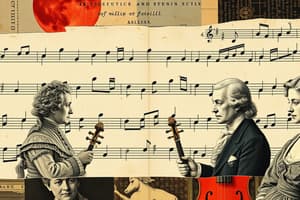Podcast
Questions and Answers
What years define the Classical Era?
What years define the Classical Era?
1750-1820
What is the time frame for the preclassical period?
What is the time frame for the preclassical period?
1730-1770
Who were among the important pioneers in the new style during the transition to the Classical period?
Who were among the important pioneers in the new style during the transition to the Classical period?
Carl Philipp Emanuel and Johann Christian
Composers in the Classical period concentrated on complexity.
Composers in the Classical period concentrated on complexity.
What texture did Classical music favor over polyphonic texture?
What texture did Classical music favor over polyphonic texture?
The term 'style galant' refers to what type of music?
The term 'style galant' refers to what type of music?
The term 'classical' has a single meaning.
The term 'classical' has a single meaning.
From which field have music historians borrowed the term 'classical'?
From which field have music historians borrowed the term 'classical'?
The music of the Classical period shows a strong direct relation to antiquity.
The music of the Classical period shows a strong direct relation to antiquity.
Who were the master composers of the Classical period?
Who were the master composers of the Classical period?
A classical composition will convey a single emotion.
A classical composition will convey a single emotion.
Mood in Classical music can change gradually or suddenly.
Mood in Classical music can change gradually or suddenly.
What type of texture is basic to Classical music?
What type of texture is basic to Classical music?
What characterizes classical melodies?
What characterizes classical melodies?
Classical melodies always have a complex structure.
Classical melodies always have a complex structure.
How do the phrases in classical melodies typically compare?
How do the phrases in classical melodies typically compare?
What distinguishes a second phrase of a melody in the Classical era?
What distinguishes a second phrase of a melody in the Classical era?
Classical melodies are difficult to sing.
Classical melodies are difficult to sing.
What evolved during the classical period concerning orchestras?
What evolved during the classical period concerning orchestras?
A classical orchestra had fewer musicians than a Baroque group.
A classical orchestra had fewer musicians than a Baroque group.
What does a classical piece have in terms of tone color?
What does a classical piece have in terms of tone color?
How were the sections of the classical orchestra organized?
How were the sections of the classical orchestra organized?
What is typical of instrumental compositions from the Classical period?
What is typical of instrumental compositions from the Classical period?
How many movements do classical symphonies and string quartets usually follow?
How many movements do classical symphonies and string quartets usually follow?
A symphony is written for what?
A symphony is written for what?
What is a string quartet written for?
What is a string quartet written for?
What is a sonata written for?
What is a sonata written for?
What might a movement contain in classical music?
What might a movement contain in classical music?
Baroque music often uses more than one main theme.
Baroque music often uses more than one main theme.
How did Haydn, Mozart, and Beethoven differ?
How did Haydn, Mozart, and Beethoven differ?
Flashcards are hidden until you start studying
Study Notes
The Classical Era Overview
- The Classical Era spanned from 1750 to 1820, marking a significant shift in music style.
- The preclassical period (1730-1770) served as a transition from the Baroque style to Classical music.
Pioneers and Influences
- Key figures in the development of Classical music included Carl Philipp Emanuel Bach (1714-1788) and Johann Christian Bach (1735-1782), who were influential in shaping new styles.
- Composers emphasized simplicity and clarity, moving away from the complexity of late Baroque music.
Musical Characteristics
- Polyphonic texture was largely set aside, favoring tuneful melodies paired with simple harmonies.
- The term "style galant" described the light and graceful music characteristic of the period.
- The classification of music as "classical" is complicated due to its varied meanings across different contexts.
Emotional Expression
- Classical compositions are notable for their emotional variability, contrasting moods within a single piece, unlike Baroque music that conveyed a single emotion.
- Mood changes can occur both gradually and suddenly, showcasing emotional complexity managed by composers.
Structure and Composition
- Classical music features a wealth of rhythmic patterns, providing greater rhythmic diversity compared to the repetitive structures found in Baroque compositions.
- Melodies are typically easy to remember, often constructed of two balanced phrases.
The Orchestra
- A standardized classical orchestra emerged, comprising strings, woodwinds, brass, and percussion, contrasting with the variable nature of Baroque ensembles.
- Classical orchestras had more musicians and displayed a wide range of tone colors through varied orchestration.
Composition Formats
- Instrumental works from this era, such as symphonies and string quartets, generally consist of multiple contrasting movements, typically arranged in a fast-slow-dance-fast pattern.
- Symphonies are designed for orchestra, while string quartets feature two violins, a viola, and a cello, and sonatas are typically written for one or two instruments.
Themes and Variations
- Classical movements may include two or more contrasting themes, in contrast to Baroque music that typically relies on a single theme.
- The incorporation of contrasting themes is a hallmark distinguishing Classical music from earlier styles.
Notable Composers
- Prominent composers of the Classical era include Joseph Haydn (1732-1809), Wolfgang Amadeus Mozart (1756-1791), and Ludwig van Beethoven (1770-1827), each bringing unique perspectives and personalities to their music.
Studying That Suits You
Use AI to generate personalized quizzes and flashcards to suit your learning preferences.




